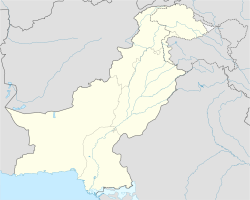Top Qs
Timeline
Chat
Perspective
Lahore Junction railway station
Railway station in Pakistan From Wikipedia, the free encyclopedia
Remove ads
Lahore Junction Railway Station (Urdu, Punjabi: لاہور جنکشن ریلوے اسٹیشن), is the main railway station in Lahore, Pakistan. It is among the oldest railway stations of the Indian subcontinent. Construction commenced shortly after the 1857 War of Independence.[1] It was built in the style of a medieval fort with thick walls, turrets, and holes to direct gun and cannon fire for the defence of the structure.[2]
It is located at the junction between Circular Road and Allama Iqbal Road and bounded on the north side by the old Grand Trunk Road. The station is now owned by Pakistan Railways, and also serves as its headquarters.
Remove ads
History
Summarize
Perspective

The station was built during the colonial era, and was built just outside the Walled City at the intersection of Empress Road, Allama Iqbal Road and Circular Road. Lahore Junction station was constructed by Mian Mohammad Sultan Chughtai, a former official of the Mughal Empire, between 1859 and 1860.[3]
The station was also a witness to a brutal lathi charge in British era that took place on 30 October 1928 near the premises of the junction when Indian leader Lala Lajpat Rai had led a protest march against the Simon Commission that had come to Lahore to discuss political reforms in the town. Rai was beaten by a wooden baton by the then Police Superintendent of Lahore and was badly wounded. Rai later died of his injuries on 17 November.
The station served as the headquarters for the Punjab Railway and later would serve as the northern terminus of the Scinde, Punjab & Delhi Railway, which connected the port city of Karachi to Lahore. The nearby Dai Anga Mosque was also converted into offices for the railways at this time. The station was built in the style of a medieval castle to ward off any potential future uprisings, as seen in the Sepoy Mutiny of 1857, with thick walls, turrets, and holes to direct gun and cannon fire for the defence of the structure.[4]
The station is a legacy of the extensive railway network established during the British Raj, and reflects the British contribution to the region's infrastructure. The station was severely affected during the riots which followed the Partition of the British Indian Empire and the independence of Pakistan in 1947. Similar to the contemporaneous situation of Muslims fleeing Delhi and Amritsar,[5] Lahore's Hindus and Sikhs were sometimes attacked at Lahore's train station.




Remove ads
Facilities
Lahore Junction Station is equipped with all basic facilities such as ticketing services, washrooms and waiting areas. The station has current and advance reservation offices for Pakistan Railways, as well as freight and parcel facilities. Retail shops are found mainly on platforms 2, 4 and 5.
Overview
The Lahore railway station is located at an elevation of 213 metres (764 ft) and was assigned the code "LHR". With this, it has become the busiest railway station of Pakistan in terms of passenger movement and train traffic. Lahore railway station has free WiFi and CCTV cameras.
Services
Summarize
Perspective
These trains serve Lahore Junction station:
Remove ads
Other Services
Pakistan Railways is headquartered in Lahore. Pakistan Railways provides an important mode of transportation for commuters and connects distant parts of the country with Lahore for business, sightseeing, pilgrimage, and education. The Lahore railway station, built during the British colonial era, is located in the heart of the city and serves as the major entry and exit point of the city. Other railway stations within Lahore include:
Remove ads
Gallery
- General View of Railway Station in June 2019
- Far view of Railway Station in 1880s
- Fortifications of Railway Station 1895 by William Henry Jackson
- Railway Station in 1880s
- Railway Station Interior View 1880s
- Train platform at Lahore Railway Station
- Lahore - entrance to railway station 1895
- Lahore - interior of railway station 1895
- Lahore - general view of railway station 1895
See also
References
External links
Wikiwand - on
Seamless Wikipedia browsing. On steroids.
Remove ads














